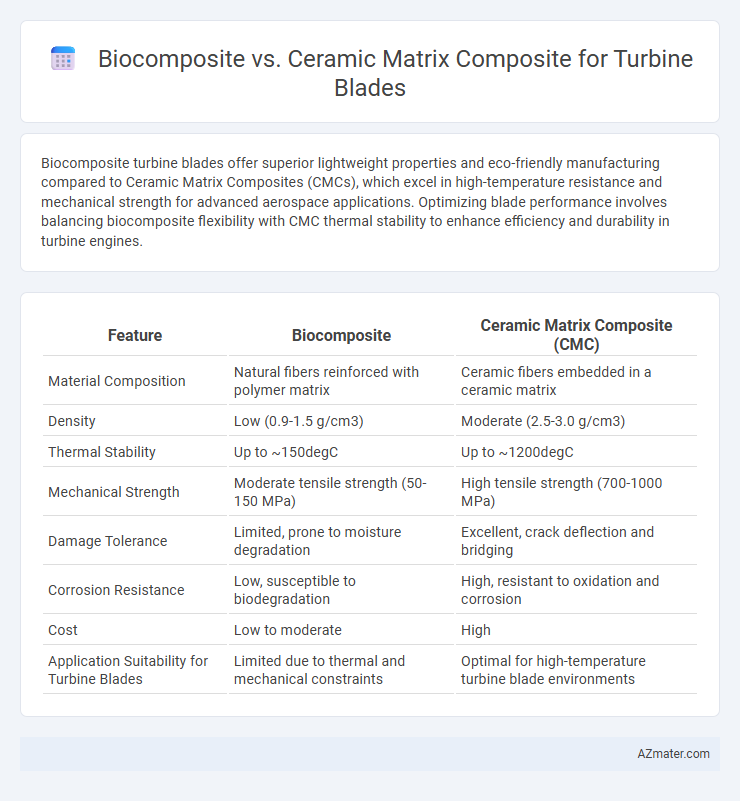Biocomposite turbine blades offer superior lightweight properties and eco-friendly manufacturing compared to Ceramic Matrix Composites (CMCs), which excel in high-temperature resistance and mechanical strength for advanced aerospace applications. Optimizing blade performance involves balancing biocomposite flexibility with CMC thermal stability to enhance efficiency and durability in turbine engines.
Table of Comparison
| Feature | Biocomposite | Ceramic Matrix Composite (CMC) |
|---|---|---|
| Material Composition | Natural fibers reinforced with polymer matrix | Ceramic fibers embedded in a ceramic matrix |
| Density | Low (0.9-1.5 g/cm3) | Moderate (2.5-3.0 g/cm3) |
| Thermal Stability | Up to ~150degC | Up to ~1200degC |
| Mechanical Strength | Moderate tensile strength (50-150 MPa) | High tensile strength (700-1000 MPa) |
| Damage Tolerance | Limited, prone to moisture degradation | Excellent, crack deflection and bridging |
| Corrosion Resistance | Low, susceptible to biodegradation | High, resistant to oxidation and corrosion |
| Cost | Low to moderate | High |
| Application Suitability for Turbine Blades | Limited due to thermal and mechanical constraints | Optimal for high-temperature turbine blade environments |
Introduction to Advanced Turbine Blade Materials
Biocomposite and ceramic matrix composite (CMC) materials offer distinct advantages for advanced turbine blade applications, with CMCs providing superior high-temperature resistance and mechanical strength critical for turbine efficiency. Biocomposites incorporate natural fibers and resins, targeting sustainability and lightweight performance but currently lack the thermal endurance of CMCs under extreme operating conditions. Ceramic matrix composites, such as silicon carbide reinforced matrices, are optimized for turbine blades due to their low density, resistance to thermal shock, and ability to operate at temperatures exceeding 1200degC, enhancing gas turbine output and durability.
What Are Biocomposites?
Biocomposites are engineered materials combining natural fibers such as flax, hemp, or jute with a polymer matrix to enhance strength and reduce environmental impact. They offer lightweight properties and biodegradability, making them attractive for sustainable turbine blade applications where weight reduction and eco-friendly materials are critical. Compared to ceramic matrix composites, biocomposites generally provide lower temperature resistance but excel in renewable resource utilization and ease of manufacturing.
What Are Ceramic Matrix Composites?
Ceramic Matrix Composites (CMCs) are advanced materials composed of ceramic fibers embedded within a ceramic matrix, designed to enhance toughness, thermal stability, and resistance to high temperatures for turbine blade applications. Unlike traditional ceramics, CMCs exhibit improved fracture toughness and damage tolerance, making them ideal for extreme operating conditions in gas turbine engines. The superior thermal resistance and lightweight nature of CMCs enable improved fuel efficiency and higher turbine inlet temperatures compared to biocomposites.
Material Properties: Biocomposite vs CMC
Biocomposites offer lightweight and sustainable solutions with moderate thermal resistance and good impact absorption, making them suitable for low-temperature turbine components. Ceramic Matrix Composites (CMCs) exhibit superior high-temperature stability, excellent oxidation resistance, and enhanced mechanical strength, ideal for turbine blades operating in extreme thermal environments. The thermal conductivity of CMCs is typically lower than metals, reducing cooling requirements, while biocomposites often lack the high-temperature durability necessary for advanced turbine applications.
Temperature Resistance of Biocomposites and CMCs
Ceramic Matrix Composites (CMCs) exhibit superior temperature resistance, typically withstanding extreme environments up to 1,200degC or higher, making them ideal for turbine blade applications. Biocomposites, composed mainly of natural fibers and biodegradable polymers, generally endure much lower temperatures, often below 300degC, limiting their use in high-temperature turbine sections. The inherent thermal stability and oxidation resistance of CMCs significantly outperform biocomposites, ensuring durability and performance in advanced turbine systems.
Mechanical Strength Comparison
Biocomposite turbine blades exhibit lower mechanical strength and stiffness compared to ceramic matrix composites (CMCs), which deliver superior high-temperature resistance and fracture toughness essential for turbine applications. CMCs offer enhanced creep resistance and higher tensile strength, making them ideal for withstanding extreme thermal and mechanical stresses in turbine engines. The inherent brittleness and lower modulus of biocomposites limit their structural integrity under the demanding conditions faced by turbine blades.
Manufacturing Processes and Scalability
Biocomposites for turbine blades utilize natural fibers embedded in polymer matrices through processes like compression molding and filament winding, offering environmentally friendly scalability but with limits in high-temperature performance. Ceramic Matrix Composites (CMCs) are produced via advanced methods such as chemical vapor infiltration and slurry infiltration, enabling superior thermal resistance and durability essential for turbine environments, though these techniques involve higher complexity and cost. Scalability for CMCs is currently more constrained due to intricate processing requirements, whereas biocomposites benefit from simpler, more adaptable manufacturing suited for larger-scale production.
Environmental Impact and Sustainability
Biocomposite turbine blades offer significant environmental advantages over ceramic matrix composites (CMCs) due to their renewable, biodegradable constituents derived from natural fibers and resins, reducing carbon footprint and reliance on non-renewable resources. While CMCs provide superior high-temperature performance, their production involves energy-intensive processes and non-recyclable materials, leading to higher environmental impact and waste concerns. The sustainability profile of biocomposites aligns better with green manufacturing initiatives, promoting lifecycle biodegradability and lower emissions in turbine blade applications.
Cost Analysis: Biocomposite vs CMC
Biocomposites offer a significant cost advantage over Ceramic Matrix Composites (CMCs) for turbine blade applications due to their lower raw material and manufacturing expenses. While CMCs provide superior high-temperature performance and durability, their complex fabrication processes and expensive constituent materials result in higher overall costs. Cost analysis reveals that biocomposites can reduce production expenditures by up to 30-50%, making them attractive for cost-sensitive applications despite potential trade-offs in thermal resistance and mechanical strength.
Future Trends in Turbine Blade Material Innovation
Future trends in turbine blade material innovation emphasize the development of ceramic matrix composites (CMCs) due to their superior high-temperature resistance, lower density, and enhanced durability compared to traditional biocomposites. Advances in CMC fabrication techniques are enabling increased thermal efficiency and operational lifespan in turbine engines by allowing blades to withstand extreme temperatures beyond the limits of metal alloys. Research into hybrid composites incorporating nano-reinforcements aims to further improve the mechanical properties and oxidation resistance, positioning CMCs as the leading material for next-generation turbine blades.

Infographic: Biocomposite vs Ceramic Matrix Composite for Turbine Blade
 azmater.com
azmater.com